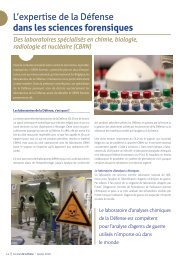Institute
XiXCVS
XiXCVS
You also want an ePaper? Increase the reach of your titles
YUMPU automatically turns print PDFs into web optimized ePapers that Google loves.
Executive Summary<br />
Since the conception of the modern state, the defence dimension, including the<br />
defence industry, has been perceived as a fundamental element of a state’s sovereignty and<br />
monopoly, principally endorsed and subsidized by national governments. Nevertheless, the<br />
defence sector is subjected to globalization processes that are determining the emergence of<br />
transnational defence markets and structures, weakening the so called national monopoly<br />
over defence industries, which in turn are creating new opportunities for transnational<br />
defence cooperation. Political consensus has been developing within the European Union<br />
(EU) milieu for defence capacity-building, but pragmatic responses remain at best declaratory<br />
and weak. An agenda to fund for defence by stealth and to generate new capabilities seems to<br />
be the way ahead: through the hybridization of civilian-military R&D and by funding for<br />
dual-use technologies such as EU-endorsed Remote Piloted Aircraft Systems (RPAS). While<br />
formally remaining an intergovernmental agency under the Council’s authority, the European<br />
Defence Agency’s (EDA) success in implementing substantive changes remains debatable,<br />
especially in terms of building a more integrated, technologically and economically superior<br />
strategy for drone development. Costly Research & Development (R&D) and Research &<br />
Technology (R&T) investment programs for security and defence purposes have always been<br />
highly controversial, especially in terms of tapping the European taxpayers’ money. The<br />
social impact of such disruptive technologies is of clear importance, especially if dual-use<br />
drones are being developed within the broader European ‘public interest’ to achieve the goals<br />
of citizens and maximize some larger social welfare function. What drives the backing of this<br />
recent policy agenda that what is it exactly that justifies and calls for financing and<br />
researching dual-use technologies such as RPAS?<br />
The views expressed are only those of the author.<br />
Keywords: genocide European Union (EU), Common Security and Defence Policy (CSDP),<br />
European Commission (EC), European Defence Agency (EDA), European Aviation Safety<br />
Agency (EASA), Capabilities-Expectations Gap, Research & Technology (R&T), Research<br />
& Development (R&D), Horizon 2020, Permanent Structured Cooperation, European<br />
Defence Technological and Industrial Base (EDTIB), Dual-Use Technology, Remote Piloted<br />
Aircraft Systems (RPAS), Unmanned Aerial Vehicles (UAVs), Hybrid Drones<br />
iii



